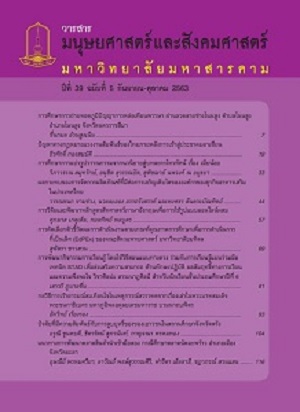ผู้ช่วยศาสตราจารย์
Main Article Content
บทคัดย่อ
การวิจัยครั้งนี้มีวัตถุประสงค์เพื่อพัฒนาบทเรียนหลักสูตรสัทศาสตร์ภาษาอังกฤษเพื่อการใช้รูปแบบออนไลน์ผสม กลุ่มตัวอย่างที่ใช้ในการวิจัยได้แก่นักศึกษาหลักสูตรครุศาสตรบัณฑิต สาขาวิชาภาษาอังกฤษ และนักศึกษาหลักสูตรศิลปศาสตรบัณฑิต สาขาวิชาภาษาอังกฤษธุรกิจ ชั้นปีที่ 2 มหาวิทยาลัยราชภัฏเพชรบุรีที่ลงทะเบียนเรียนรายวิชาสัทศาสตร์ภาษาอังกฤษเพื่อการใช้ประจำภาคเรียนที่ 2 ปีการศึกษา 2561 จำนวน 67 คน โดยใช้วิธีสุ่มแบบเฉพาะเจาะลง (Purposive Sampling) เครื่องมือที่ใช้ในการวิจัยได้แก่ 1) บทเรียนวิชาสัทศาสตร์ภาษาอังกฤษเพื่อการใช้รูปแบบออนไลน์ผสม 2)แบบทดสอบวัดผลสัมฤทธิ์ทางการเรียน เป็นแบบทดสอบก่อนเรียนและหลังเรียน 3) แบบประเมินประสิทธิภาพระบบการเรียนรูปแบบผสมออนไลน์ (LMS) จากผู้เชี่ยวชาญด้านเทคโนโลยีการศึกษา 4) แบบประเมินความพึงพอใจของบทเรียนวิชาสัทศาสตร์ภาษาอังกฤษเพื่อการใช้รูปแบบผสมออนไลน์ สถิติที่ใช้ในการวิเคราะห์ข้อมูลได้แก่ การค่าประสิทธิภาพของบทเรียน ค่าเฉลี่ย ส่วนเบี่ยงเบนมาตรฐาน และการทดสอบค่าที ผลการวิจัยพบว่า ด้านประสิทธิภาพของบทเรียนออนไลน์ มีประสิทธิภาพ 82.84/94.73 สูงกว่าเกณฑ์ที่กำหนดไว้ และด้านผลสัมฤทธิ์ทางการเรียนด้วยบทเรียนออนไลน์ ค่าเฉลี่ยของคะแนนทดสอบหลังเรียนมีค่ามากกว่าคะแนนทดสอบก่อนเรียนอย่างมีนัยสำคัญทางสถิติที่ระดับ .05 ค่าความพึงพอใจต่อการเรียนอยู่ในระดับมาก
Article Details
เอกสารอ้างอิง
Behjat, F., Yamini, M., & Bagheri, M. S. (2012). Blended learning: A ubiquitous learning environment for reading comprehension. International Journal of English Linguistics. 2 (1): Available from: http://dx.doi.org/10.5539/ijel.v2n1p97
Cheng, S.-C., Hwang, W.-Y., Wu, S.-Y., Shadiev, R., & Xie, C.-H. (2010). A mobile device and online system with contextual familiarity and its effects on English learning on campus. Educational Technology & Society. 13(3): 93–109
Colpaert, J. (2004). From courseware to courseware? Computer Assisted Language Learning. 17(3-4): 261-266A
Hojnacki, S. (2016). Oral Output in Online Modules vs. Face-To-Face Classrooms. In McCarthy, M. (Ed.), The Cambridge Guide to Blended Learning for Language Teaching. Cambridge: Cambridge University Press. 107-122.
Johnson, R. F. (2013). Student attitudes toward blended and online courses: A comparison of students in traditional classroom writing environments and students in online classroom environment [Dissertation]. University of North Texas.
Johnson, C. P., & Marsh, D. (2013). The Laureate English Program: Taking a research informed approach to blended learning. Higher Learning Research Communications. Available from: http://journals.sfu.ca/liu/index.php/HLRC/article/view/103
King, T. (2016). The ‘Onstream’ Project: Collaboration between teachers in mainstream and supplementary schools. In A. Beaven, A. Comas-Quinn & B. Sawhill (Eds.), Case Studies of Openness in the Language Classroom. Dubin: Vollians. 110-120.
Kirkwood, A. (2004). Networked learning in context: What does e-learning offer students working independently, and what do they bring to it? In D. Murphy, R. Carr, J. Taylor & T. Wong (Eds.), Distance Education and Technology: Issues and
Practice. Hong Kong: Open University of Hong Kong Press. 217-229.
Kirkwood, A. T., Price, L. (2005). Learners and learning in the twenty-first century: What do we know about students’ attitudes towards and experiences of information and communication technologies that will help us design courses? Studies in
Higher Education. 30(3): 257-274
Krashen, S. (1985). The Input Hypothesis: Issues and Implications. London: Longman.
Kukulska-Hulme, A. (2009). Will mobile learning change language learning? ReCALL, 21(2): Available from: http://goo.gl/Pbv5n
Lee, S., & Lee, C.H. (2013). A case study on the effects of an L2 writing instructional model for blended learning in higher education. Turkish Online Journal of Educational Technology. 12(4): 1-10
Marsh, D. (2012). Blended learning: Creating learning opportunities for language earners. New York: Cambridge University Press.
Nakazawa, K. (2009). Student engagement in online language learning: A case study examining the online delivery of tertiary language courses. The International Journal of Learning. 16(7): 405-414
Oweis, T. (2018). Effects of using a blended learning method on students’ achievement and motivation to learn English in Jordan: A pilot case study. Hindawi Education Research International. Article ID #7425924: Available from:
https://www.hindawi.com/journals/edri/2018/7425924/
Swain, M. (1985). Communicative competence: Some roles of comprehensible input and comprehensible output in its development. In S. Gass & C. Madden (Eds.), Input in Second Language Acquisition. Rowley (MA) : Newbury House. 235-253.
________. (2005). The output hypothesis: Theory and research. In E. Hinkel (Ed.), Handbook on Research in Second Language Teaching and Learning. Mahwah (NJ) : Lawrence Erlbaum Associates. 471-484.
Wu, J., & Liu, W. (2013). An empirical investigation of the critical factors affecting students' satisfaction in EFL blended learning. Journal of Language Teaching & Research, 4(1): 176-185


